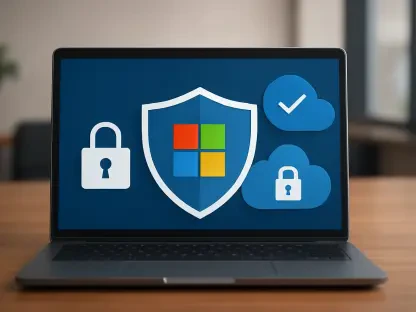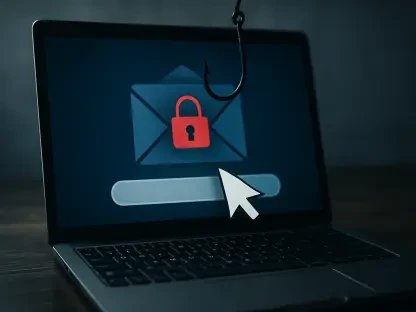In an era where digital communication dominates every aspect of life, the line between genuine messages and malicious traps has become alarmingly blurred, especially with the rise of artificial intelligence (AI) crafting near-perfect phishing emails that deceive even the most cautious individuals. A recent global survey conducted by Talker Research for Yubico, involving 18,000 employed adults across nine countries, uncovers a troubling reality: most people struggle to differentiate between authentic correspondence and AI-generated scams. This pervasive issue not only threatens personal data but also jeopardizes professional security, as cybercriminals exploit human vulnerabilities with unprecedented sophistication. The challenge of spotting phishing attempts in today’s fast-paced online environment is no longer just a technical hurdle—it’s a critical skill gap that demands urgent attention. As AI continues to evolve, the stakes grow higher, making it essential to understand the depth of this problem and explore actionable solutions to safeguard against these digital deceptions.
The Rising Threat of AI-Driven Phishing
Spotting the Unseen Danger
The advent of AI has transformed phishing from a rudimentary scam into a highly sophisticated threat that mimics human communication with eerie precision. According to the global survey, a staggering 54% of respondents either mistook an AI-generated phishing email for a human-written one or remained unsure of its authenticity. This statistic underscores a profound challenge: AI tools can replicate tone, grammar, and even personal details, creating messages that appear legitimate at first glance. The technology’s ability to analyze vast amounts of data enables scammers to tailor their attacks, making them resonate with specific targets. As a result, even cautious individuals find themselves second-guessing emails that once would have raised obvious red flags. This growing indistinguishability signals a pressing need for heightened vigilance and new strategies to combat these advanced threats.
Beyond the technical prowess of AI, the psychological tactics employed in these phishing attempts exploit fundamental human tendencies, such as trust in familiar formats or urgency cues. Many phishing emails now mimic corporate branding or personal contacts so convincingly that recipients lower their guard without realizing the deception. The survey revealed that only 30% of participants could correctly identify a genuine, human-written email, highlighting a widespread uncertainty that scammers capitalize on. This lack of discernment isn’t just a personal failing—it’s a systemic issue that reflects how quickly technology has outpaced traditional cybersecurity awareness. Addressing this unseen danger requires not only better tools but also a shift in how digital literacy is approached in both personal and professional spheres.
The Cost of a Click
Engaging with a phishing message might seem like a minor misstep, but the repercussions can be devastating, affecting both individuals and organizations on a massive scale. The survey found that 44% of respondents had interacted with a phishing attempt in the past year, whether by clicking a suspicious link or downloading a malicious attachment. These interactions often lead to the exposure of sensitive information, such as email addresses, full names, and phone numbers, which can be weaponized for identity theft or further attacks. The financial and emotional toll of such breaches is immense, often resulting in lost funds, damaged reputations, and prolonged recovery efforts. This widespread prevalence of successful phishing attacks illustrates how a single click can unravel layers of security.
The methods through which these attacks are delivered add another dimension to their impact, with 51% arriving via email, 27% through text messages, and 20% via social media platforms. Scammers exploit the perceived authenticity of these channels, often crafting messages that appear to come from trusted sources like banks or colleagues. The survey noted that 34% of victims fell for scams due to this apparent legitimacy, while 25% cited being rushed as a contributing factor. The fallout from these interactions isn’t just personal—when work accounts are compromised, entire organizations face risks of data breaches and operational disruptions. Understanding the true cost of these seemingly innocuous actions is crucial to fostering a culture of caution in digital interactions.
Generational Gaps and Risky Behaviors
Age and Engagement with Scams
While the ability to identify phishing emails remains uniformly low across age groups, the likelihood of engaging with these scams varies significantly by generation, painting a complex picture of digital risk. The survey data shows that Gen Z, at 62%, is far more likely to interact with phishing messages compared to Baby Boomers, who sit at just 23%. This discrepancy isn’t rooted in a lack of awareness—recognition rates hover around 45-47% for all groups—but rather in behavioral patterns. Younger generations, immersed in a hyper-digital world, encounter more frequent online interactions, increasing their exposure to potential threats. Their comfort with technology, while an asset in many ways, can sometimes translate into overconfidence or desensitization to risks, making them prime targets for scammers.
This generational divide in engagement also reflects differing priorities and contexts in which digital communication occurs. Younger individuals often multitask across platforms, juggling personal and professional messages in rapid succession, which can lead to hasty decisions. In contrast, older generations may approach online interactions with more caution, partly due to less frequent engagement with digital tools or a historical skepticism toward unfamiliar messages. However, this caution doesn’t fully shield them, as scammers adapt tactics to exploit any demographic. The challenge lies in tailoring cybersecurity education to address these behavioral nuances, ensuring that younger users are equipped with the discipline to pause and assess, while older users gain confidence in navigating modern threats without undue fear.
Blurring Personal and Work Boundaries
The increasing overlap between personal and professional digital environments poses a significant security risk, particularly among younger generations who seamlessly blend these spheres. The survey highlights that 50% of respondents log into work accounts using personal devices, while 40% access personal email and 17% conduct online banking on work devices. For Gen Z, only 30% stick to work-permitted devices, compared to 66% of Baby Boomers, revealing a stark generational contrast. This cross-contamination of devices creates vulnerabilities, as a breach in one domain can easily spill over into the other, amplifying the potential for data loss or unauthorized access. The convenience of using a single device for multiple purposes often overshadows the inherent dangers, leaving both individuals and organizations exposed.
This blurring of boundaries isn’t just a personal habit—it’s a structural issue exacerbated by remote work trends and the proliferation of bring-your-own-device (BYOD) policies in workplaces. When personal smartphones or laptops become entry points for phishing attacks, the compromised data often includes sensitive corporate information, turning an individual oversight into a company-wide liability. The risk is further compounded by inconsistent security settings across devices, where personal accounts might lack the robust protections mandated by employers. Addressing this challenge requires clear policies on device usage, coupled with technology solutions that segregate personal and professional data, ensuring that a single phishing email doesn’t trigger a cascading failure across both realms.
Organizational Failures in Cybersecurity
Lack of Training and Support
A critical barrier to effective cybersecurity lies in the alarming lack of training provided by many organizations, leaving employees ill-prepared to tackle sophisticated phishing threats. According to the survey, 40% of respondents reported receiving no cybersecurity education from their employers, a gap that directly contributes to the high rates of successful phishing attacks. Without regular guidance on identifying suspicious messages or understanding the latest scam tactics, workers are left to rely on instinct or outdated knowledge, which often falls short against AI-driven deceptions. This absence of structured learning not only endangers individual employees but also weakens the overall security posture of the organization, as human error becomes an easy exploit for cybercriminals.
The consequences of inadequate training extend beyond immediate breaches, fostering a culture of complacency where cybersecurity is seen as an IT department concern rather than a shared responsibility. Employees who lack formal instruction may not recognize the importance of seemingly minor actions, like verifying sender details or avoiding unfamiliar links, leading to preventable incidents. Moreover, the absence of training often correlates with a lack of awareness about reporting mechanisms for suspicious activity, delaying response times to potential threats. To counter this, companies must prioritize comprehensive, ongoing education programs that empower staff with practical skills and reinforce the critical role each person plays in maintaining digital safety across the board.
Inconsistent Security Practices
Beyond training deficits, many organizations suffer from inconsistent security protocols that create exploitable gaps in their defenses against phishing attacks. The survey revealed that 49% of respondents noted their workplaces used multiple authentication methods across different applications, rather than a standardized, secure approach like multi-factor authentication (MFA). This patchwork of security measures often leads to confusion among employees, who may struggle to navigate varying requirements or inadvertently bypass critical protections. Such inconsistencies not only undermine the effectiveness of security systems but also provide cybercriminals with opportunities to target weaker entry points within an organization’s digital infrastructure.
The lack of uniformity in security practices is often compounded by role-based discrepancies, with 44% of respondents indicating that security requirements differ by position or title within their companies. This fragmented approach can result in some departments or individuals being less protected, creating vulnerabilities that affect the entire organization when phishing attacks succeed. A unified strategy, incorporating phishing-resistant solutions like security keys and consistent MFA across all platforms, is essential to close these gaps. By standardizing protocols, companies can reduce the likelihood of breaches stemming from procedural confusion and ensure that every employee operates within a fortified digital environment, regardless of their role or access level.
Human Error and the Path Forward
The Human Factor in Cyber Threats
At the core of many cybersecurity breaches lies human error, a persistent and often underestimated factor that scammers exploit with precision in their phishing campaigns. The survey found that 34% of individuals who fell for phishing attacks did so because the message appeared authentic, while 25% attributed their lapse to being rushed and failing to scrutinize content. This susceptibility to deception, whether due to trust in a seemingly legitimate source or the pressures of a hectic schedule, highlights how behavioral tendencies can override even the best technical defenses. People are frequently their own weakest link, making decisions in moments of distraction that open the door to significant data breaches and financial losses.
This human element is particularly challenging because it transcends technological solutions, rooted instead in psychological and situational factors that vary widely among individuals. For instance, a well-crafted phishing email mimicking an urgent work request can trigger an instinctive response to act quickly, bypassing rational checks. Similarly, familiarity with certain communication styles or brands can lull recipients into a false sense of security, even when subtle warning signs are present. Tackling this issue requires a dual approach: fostering a mindset of skepticism toward unsolicited messages and creating environments where employees feel supported to take the time needed for verification, rather than penalized for perceived delays in response.
Building Stronger Defenses
Despite the daunting challenges posed by AI-driven phishing, there are concrete steps that can significantly bolster defenses for both individuals and organizations navigating the digital landscape. Experts advocate for widespread adoption of multi-factor authentication (MFA), a proven method to add layers of security beyond simple passwords, yet the survey shows 30% of respondents have not enabled it on personal accounts. Additionally, phishing-resistant tools like security keys offer a robust barrier against credential theft, providing a physical component that scammers cannot replicate remotely. These technologies, when paired with regular software updates and strong password practices, form a formidable shield against the evolving tactics of cybercriminals targeting unsuspecting users.
Equally important is the role of education and policy in building resilience against phishing threats, as technical solutions alone cannot address the human vulnerabilities at play. Companies should implement mandatory, recurring cybersecurity training that covers the latest scam techniques and emphasizes practical response strategies, ensuring employees are not just aware but also confident in their actions. At the individual level, cultivating habits like double-checking sender addresses and avoiding clicks on unsolicited links can make a significant difference. Looking ahead, the integration of AI in defensive tools—used to detect and flag suspicious messages before they reach inboxes—holds promise for leveling the playing field. By combining advanced technology with informed human judgment, a safer digital future is within reach, provided the commitment to improvement remains steadfast.









